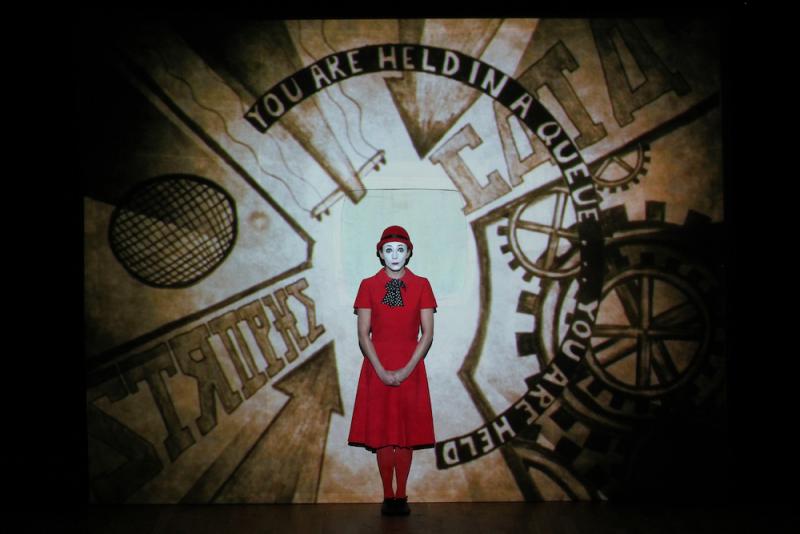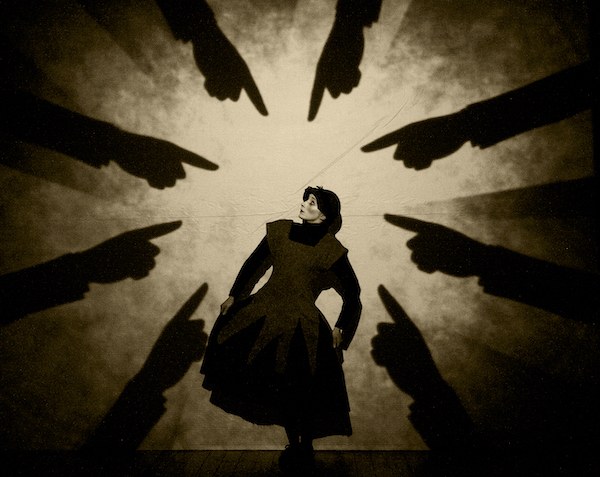The Animals and Children Took to the Streets, Lyric Hammersmith review - enchanting graphic novel | reviews, news & interviews
The Animals and Children Took to the Streets, Lyric Hammersmith review - enchanting graphic novel
The Animals and Children Took to the Streets, Lyric Hammersmith review - enchanting graphic novel
1927 theatre company returns with its classic hit show - as beautifully compelling as ever

Whenever I hear the word "cosmopolitan" I think of Europe in the 1920s: German Expressionism, Russian Constructivism, Czech eccentricity, Swiss DaDa, Italian Futurism and French Surrealism. With music from Weimar cabaret and visuals by Soviet agit-prop. Let's take an imaginary train journey from Paris to Berlin to Zurich to Prague to Milan. This is the world evoked by The Animals and Children Took to the Streets.
Written and directed by Suzanne Andrade, the story opens in Bayou Mansions, a dirty tenement block on Red Herring Street, on the edge of an unnamed European city. It's a slum. Life here is shit. There is dirt; there are rats; there are cockroaches. The people are poor. Some are perverts; others are racists. But what's this? Oh, a group of feral kids, who are up to no good. They make noise and smash windows. Meanwhile, Agnes Eaves – a liberal, middle-class do-gooder – and her little daughter Evie move into the block. Agnes wants to help the kids by providing them with arts and crafts. But the ungrateful brats just break up the Art Club.
The play brings to mind the image of the little person
One of them, Zelda, spawn of a drunk and petty crim, organises a special gang of child-pirates – decked out in bandanas and eye patches – who go on the rampage. Zelda's manifesto is the politics of envy: her repeated cry, "We want what you have out there", shows that the poor kids are ready to expropriate the rich. They take over a middle-class park, the pride and joy of the city's mayor, and then they go too far: they kidnap the mayor's cat. So he fights back, armed with sedative sweets and, like a modern-day Pied Piper, the ability to entice the kids, including Evie, away from their slum tenements to a sinister rehabilitation centre. Can Agnes, helped by the Bayou Mansions' kindly old caretaker, find her daughter alive?
In 70 minutes, this exciting fantasy tale is told using a mixture of only three actors (Genevieve Dunne, Rowena Lennon and Felicity Sparks) and continuous animated projections, to the insistent and lilting sound of music. The effect is truly wonderful: a beguiling atmospheric picture show which conjures up Central Europe of the 1920s, contemporary graphic novels and even a dash of good old English pantomime. Sometimes comedic, sometimes slightly melancholy, the play brings to mind the image of the little person who is pitted against authority, of individiuality against conformity. You are reminded of Charlie Chaplin, or Emile and the Detectives. Both Agnes and the Caretaker are essentially powerless, archetypal little people, yet they must take on the frustrating bureaucratic rules and regulations of power as they cross the city in their quest for little Evie. While the mayor deploys gum drops laced with debilitating drugs (a chemical cosh), the stakes rise as the contemporary significance of this urban fairy tale sneaks into your consciousness. For the story evokes a past when kids were free to play in the streets, when being naughty was inconvenient rather than dangerous. It also suggests that children are still objects of suspicion. Whose autonomy we fear. And, as you'd expect from a company that calls itself 1927, there is a lot of historical resonance in the visual aesthetic: some passages (pictured above) are reminiscent of Soviet-style iconography; others bring to mind the worlds of Franz Kafka or even Kurt Weill; Fritz Lang hovers somewhere on the dystopic edges of this creation.
Both Agnes and the Caretaker are essentially powerless, archetypal little people, yet they must take on the frustrating bureaucratic rules and regulations of power as they cross the city in their quest for little Evie. While the mayor deploys gum drops laced with debilitating drugs (a chemical cosh), the stakes rise as the contemporary significance of this urban fairy tale sneaks into your consciousness. For the story evokes a past when kids were free to play in the streets, when being naughty was inconvenient rather than dangerous. It also suggests that children are still objects of suspicion. Whose autonomy we fear. And, as you'd expect from a company that calls itself 1927, there is a lot of historical resonance in the visual aesthetic: some passages (pictured above) are reminiscent of Soviet-style iconography; others bring to mind the worlds of Franz Kafka or even Kurt Weill; Fritz Lang hovers somewhere on the dystopic edges of this creation.
The words by Andrade are both gently humorous and satirically insisive, while the film animation and design by her co-creator Paul Barritt gets a lift from Lillian Henley's music. The three actors have clown-like white faces and interact perfectly with the projections and film. It really is brilliant entertainment. But what does it all mean? Originally, The Animals and Children Took to the Streets seemed to predict the social unrest of the 2011 riots; today its vision of social despair and destined communities, of the divison between shiny city and dilapidated slums, rich and poor, still rings true. And the device of offering two alternative endings is thrillingly ambiguous: on one reading, the story is a council of despair; on another it is a Brechtian provocation. You don't like our society? You have nothing to lose? Then go out, says this cartoon, and change the world.
The future of Arts Journalism
You can stop theartsdesk.com closing!
We urgently need financing to survive. Our fundraising drive has thus far raised £49,000 but we need to reach £100,000 or we will be forced to close. Please contribute here: https://gofund.me/c3f6033d
And if you can forward this information to anyone who might assist, we’d be grateful.

Subscribe to theartsdesk.com
Thank you for continuing to read our work on theartsdesk.com. For unlimited access to every article in its entirety, including our archive of more than 15,000 pieces, we're asking for £5 per month or £40 per year. We feel it's a very good deal, and hope you do too.
To take a subscription now simply click here.
And if you're looking for that extra gift for a friend or family member, why not treat them to a theartsdesk.com gift subscription?
more Theatre
 Ragdoll, Jermyn Street Theatre review - compelling and emotionally truthful
Katherine Moar returns with a Patty Hearst-inspired follow up to her debut hit 'Farm Hall'
Ragdoll, Jermyn Street Theatre review - compelling and emotionally truthful
Katherine Moar returns with a Patty Hearst-inspired follow up to her debut hit 'Farm Hall'
 Troilus and Cressida, Globe Theatre review - a 'problem play' with added problems
Raucous and carnivalesque, but also ugly and incomprehensible
Troilus and Cressida, Globe Theatre review - a 'problem play' with added problems
Raucous and carnivalesque, but also ugly and incomprehensible
 Clarkston, Trafalgar Theatre review - two lads on a road to nowhere
Netflix star, Joe Locke, is the selling point of a production that needs one
Clarkston, Trafalgar Theatre review - two lads on a road to nowhere
Netflix star, Joe Locke, is the selling point of a production that needs one
 Ghost Stories, Peacock Theatre review - spirited staging but short on scares
Impressive spectacle saves an ageing show in an unsuitable venue
Ghost Stories, Peacock Theatre review - spirited staging but short on scares
Impressive spectacle saves an ageing show in an unsuitable venue
 Hamlet, National Theatre review - turning tragedy to comedy is no joke
Hiran Abeyeskera’s childlike prince falls flat in a mixed production
Hamlet, National Theatre review - turning tragedy to comedy is no joke
Hiran Abeyeskera’s childlike prince falls flat in a mixed production
 Rohtko, Barbican review - postmodern meditation on fake and authentic art is less than the sum of its parts
Łukasz Twarkowski's production dazzles without illuminating
Rohtko, Barbican review - postmodern meditation on fake and authentic art is less than the sum of its parts
Łukasz Twarkowski's production dazzles without illuminating
 Lee, Park Theatre review - Lee Krasner looks back on her life as an artist
Informative and interesting, the play's format limits its potential
Lee, Park Theatre review - Lee Krasner looks back on her life as an artist
Informative and interesting, the play's format limits its potential
 Measure for Measure, RSC, Stratford review - 'problem play' has no problem with relevance
Shakespeare, in this adaptation, is at his most perceptive
Measure for Measure, RSC, Stratford review - 'problem play' has no problem with relevance
Shakespeare, in this adaptation, is at his most perceptive
 The Importance of Being Earnest, Noël Coward Theatre review - dazzling and delightful queer fest
West End transfer of National Theatre hit stars Stephen Fry and Olly Alexander
The Importance of Being Earnest, Noël Coward Theatre review - dazzling and delightful queer fest
West End transfer of National Theatre hit stars Stephen Fry and Olly Alexander
 Get Down Tonight, Charing Cross Theatre review - glitz and hits from the 70s
If you love the songs of KC and the Sunshine Band, Please Do Go!
Get Down Tonight, Charing Cross Theatre review - glitz and hits from the 70s
If you love the songs of KC and the Sunshine Band, Please Do Go!
 Punch, Apollo Theatre review - powerful play about the strength of redemption
James Graham's play transfixes the audience at every stage
Punch, Apollo Theatre review - powerful play about the strength of redemption
James Graham's play transfixes the audience at every stage
 The Billionaire Inside Your Head, Hampstead Theatre review - a map of a man with OCD
Will Lord's promising debut burdens a fine cast with too much dialogue
The Billionaire Inside Your Head, Hampstead Theatre review - a map of a man with OCD
Will Lord's promising debut burdens a fine cast with too much dialogue

Add comment